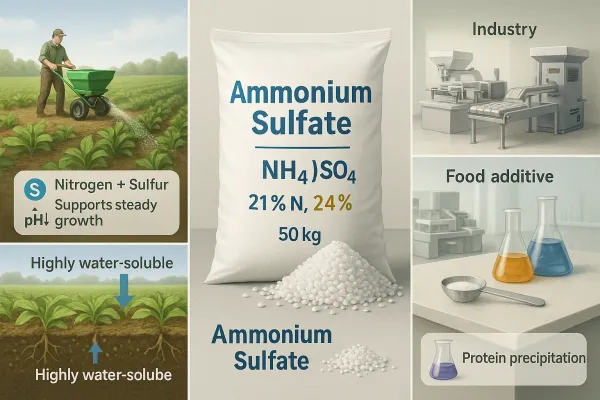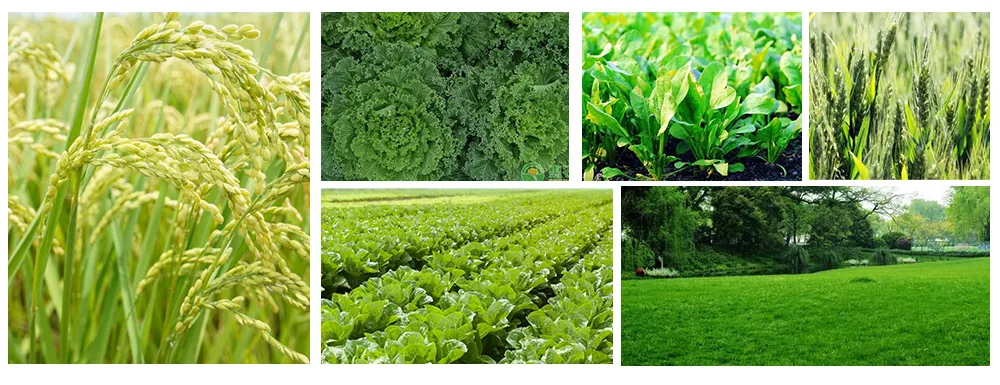Avoid your inquiry is delay response, please enter your WhatsApp/Skype along with the message, so we can contact you at the very first time.
We will reply you within 24 hours. If for urgent case, please add WhatsApp/WeChat:
Warning: Undefined variable $public in /www/wwwroot/lvfertilizer.com/wp-content/themes/hyhadmin/header.php on line 350
Warning: Trying to access array offset on value of type null in /www/wwwroot/lvfertilizer.com/wp-content/themes/hyhadmin/header.php on line 350
,. Or call
Warning: Undefined variable $public in /www/wwwroot/lvfertilizer.com/wp-content/themes/hyhadmin/header.php on line 350
Warning: Trying to access array offset on value of type null in /www/wwwroot/lvfertilizer.com/wp-content/themes/hyhadmin/header.php on line 350
directly.
Many fields show pale leaves and slow growth. That’s nutrient stress. Ammonium sulfate (ammonium sulphate) is a simple, proven fertilizer that restores nitrogen and sulfur so plants bounce back fast.
Ammonium sulfate is widely used as a fertilizer in agriculture because it supplies a source of nitrogen and sulfur, helps lower soil pH on alkaline soils, and supports steady plant growth. Beyond farming, it’s also used as a food additive and to precipitate proteins in laboratories. It’s soluble in water, easy to handle, and readily available to plants.

Ammonium sulfate—spelled ammonium sulphate in British English—is a crystalline, inorganic salt with the chemical formula (NH4)2SO4. It’s extremely soluble in water, stable, and easy to store. As a chemical fertilizer, ammonium sulfate contains essential nitrogen in the ammonium form and plant-available sulfur as sulfate.
Farmers choose ammonium sulfate fertilizer because it delivers nitrogen and sulfur together. That two-in-one package fits crops that need both nutrients at the same time for steady crop growth. Typical grades show it contains 21 percent nitrogen and about 24 percent sulfur, so you feed leaves and proteins (from nitrogen) while boosting oil and enzyme systems (from sulfur).
“We manufacture consistent, low-dust granules that spread evenly and dissolve fast in the field.”
— Perspective from our production team in China (leading fertilizer exporter)
For buyers comparing fertilizer sources, ammonium sulfate is nitrogen plus sulfate-sulfur in a proven, predictable product that works across climates.
See our high-quality ammonium sulphate fertilizer granules and specs for bulk orders: ammonium sulphate fertilizer 20.5% N.
Once applied directly to the soil, the ammonium ion is released from ammonium sulfate. That ion is released and forms nitrate over time through nitrification; in the process a small amount of acid is produced. Put simply, it released and forms a small acidity pulse that can lower soil pH right where granules dissolve.
Over days to weeks, n in ammonium sulfate converts to nitrate, so ammonium sulfate converts to nitrate that roots can take up quickly. Because part of the N starts in the ammonium form, it’s less prone to immediate nitrogen losses from leaching than applying only nitrate. This is why ammonium sulfate provides steady nutrient release and is readily available to plants.
Field crops. In cereals, corn, rice, and oilseeds, ammonium sulfate is commonly used when tests show sulfur deficiency or when soils are cool and wet. The use of ammonium sulfate early supports roots and tillering; a second pass near stem elongation can push crop yields and protein.
Vegetables and fruit. Leafy greens, onions, brassicas, and potatoes respond to the combined nitrogen and sulfur nutrition. Where quality and color matter, growers use ammonium sulfate to keep uniform growth.
Turf and lawns. For cool-season grasses, spreading ammonium sulfate on the soil surface in spring or fall gives a fast green-up without excessive surge growth. For lawn care pros, it’s a dependable nitrogen fertilizer with built-in sulfate.
If you prefer a nitrate-forward option in cool conditions, see calcium ammonium nitrate (CAN) fertilizer for side-dress programs: calcium ammonium nitrate fertilizer.

Choosing a fertilizer depends on your soil, weather, and equipment. Here’s a simple comparison:
| Fertilizer | Nitrogen (%) | Sulfur (%) | Notes |
|---|---|---|---|
| Ammonium sulfate (ammonium sulphate) | ~21 | ~24 | Acidifies zone; great for alkaline soils or sulfur-deficient fields. |
| Urea | 46 | 0 | Highest analysis; needs incorporation to limit volatilization of ammonia. |
| Ammonium nitrate | 34 | 0 | Fast-acting; regulated in many regions. |
Low nitrogen content relative to urea is the main disadvantage to the use of ammonium sulfate; its nitrogen content relative to ammonium nitrate is lower too. Put another way, the sulfate is its low nitrogen analysis trade-off. But if you need sulfur and mild acidification, ammonium sulfate is often the best fit.
Tip: For blends that deliver both N and P, plants also respond to mixes including ammonium phosphate or NPK grades.
Explore balanced NPK options to complement ammonium sulfate side-dress, like NPK 12-12-12 compound fertilizer for base dressing: NPK 12-12-12 compound fertilizer.
Rates. Base rates on soil tests and crop removal. For many row crops, 50–150 kg N/ha total is typical across all sources; apply ammonium sulfate to cover part of that when sulfur is needed.
Timing. Split n application to reduce loss and match uptake—starter at planting, then side-dress. In turf, low, frequent feedings avoid burn when used in excess.
Placement. Broadcast and incorporate, banded beside the row, or surface-applied before rain/irrigation. Because it’s soluble in water, granules dissolve quickly with moisture.
For flexible blending programs, see our custom fertilizer blends for BB/bulk blending: custom fertilizer blends.
Yes—where the granule dissolves, ammonium sulfate can help lower high soil pH. The acidification comes from nitrification of the ammonium and the sulfate’s influence on the soil solution. That’s why it’s often called a fertilizer for alkaline soils.
In calcareous soils, sulfate functions to bind iron and calcium cations in the solution phase or shift equilibria so micronutrients stay usable. Over time and with repeated use, expect small pH changes near the band. Always re-test soil pH to track progress.
For a nitrogen-forward alternative when acidification is less critical, review our nitrogen fertilizer solutions designed for fast growth: water-soluble nitrogen fertilizer.
Blends. AS granules mix well with MAP/DAP and potash in dry plants. As an inorganic salt, it flows cleanly. Watch blend ratios and concentration to prevent segregation.
Fertigation. Because it’s soluble in water (high solubility), you can dose through drip lines and pivots. Maintain a clean source and filters; avoid overshooting EC. In solution, ammonium sulfate stays available and supports steady uptake.
Foliar. In low doses, foliar sprays can supplement nutrient needs. Start with small trials and avoid heat.
Pair AS with water-soluble programs like water-soluble NPK 20-20-20 for balanced feeding: NPK 20-20-20 TE water-soluble fertilizer.

Protein work. In biochemistry, sulfate is used to precipitate proteins. Adjusting salt levels lets techs fractionate and purify enzymes—classic “ammonium sulfate precipitation.”
Food additive. Food processors may list it as food additive E517; small doses condition dough and yeast foods.
Air quality. In the atmosphere, air pollution particles often contain ammonium sulfate formed when ammonia reacts with sulfur oxides.
Lab ammonia. In teaching labs, the salt is used to make ammonia by reacting with strong bases; the released ammonia gas is captured and measured.
Don’t confuse salts. Ammonium chloride and other ammonium salts are different materials with different handling guidelines.
Storage. Keep in a dry shed. The crystals are hygroscopic, but with ventilation they store well.
Compatibility. Blend with most ammonium compounds and phosphates; avoid mixing with free lime or strong alkali that can drive off ammonia gas. In liquids, watch pH.
Salt safety. Any chemical fertilizer can scorch leaves if piled on the crown. Calibrate spreaders. If used in excess, flush with irrigation.
Learn how we manufacture and export consistent fertilizers at scale: About our fertilizer manufacturing.
Oilseed example. A canola field on sandy soil showed yellowing at the 4–6 leaf stage. A single pass of ammonium sulfate fertilizer at 100 kg/ha provided essential nitrogen and sulfate. Result: strong canopy and higher oil content at harvest.
Vegetable example. Onion beds responded to side-dress bands of ammonium sulfate at bulb initiation. Better color and uniform bulb size brought premium grades.
For base nutrition in vegetable beds, pair AS with a balanced starter like NPK 12-12-12 before transplanting: NPK 12-12-12 compound fertilizer.
What’s the difference between ammonium sulfate and ammonium sulphate?
Spelling only. Both name the same inorganic salt used as a fertilizer.
Does it really acidify soil?
Yes, modestly. As the ammonium oxidizes, acidity forms and can lower soil pH near the granule, helpful on alkaline soils.
How fast does the nitrogen work?
Part works immediately; then ammonium sulfate converts to nitrate. That staged release sustains plant growth.
Is ammonium sulfate considered generally safe for crops?
Yes, ammonium sulfate is considered generally safe when labeled rates are followed. Avoid piling granules on stems/leaves.
Can I mix it with other fertilizers?
Yes. It blends well with potash and phosphates; many buyers combine it with MAP/DAP or balanced NPK. Check product sheets for specific ratios.
Is it soluble in water for fertigation?
Yes—very. It’s soluble and dissolves cleanly for drip or pivot injection.
For balanced water feeding, see our water-soluble portfolio alongside AS: NPK 20-20-20 TE water-soluble fertilizer.
(These are general references that align with standard agronomy practice; consult your local extension and regulations for site-specific guidance.)
| Topic | Why it matters |
|---|---|
| N + S package | Two key nutrient streams in one pass |
| Acidification | Tames high soil pH zones for better micronutrient uptake |
| Handling | Free-flowing granules; soluble in water for liquid programs |
| Flexibility | Stand-alone or blended; broadcast, band, or fertigation |
| Value | Strong economics where sulfur is limiting |
Ammonium sulfate : ███████ (≈21% N)
Ammonium nitrate : ██████████████ (≈34% N)
Urea : ██████████████████████ (46% N)
As a leading manufacturer and exporter in China, we supply consistent ammonium sulfate (ammonium sulphate) and integrated NPK programs. If you’d like a field-ready plan for your soil and crop, tell us your target yield, timing, and equipment. We’ll design a simple schedule you can trust.
| Property | Detail |
|---|---|
| Formula | (NH₄)₂SO₄ |
| Nutrient Content | 21% N, 24% S |
| Solubility | Highly soluble in water |
| Effect on Soil pH | Lowers pH (acidifies alkaline soils) |
| Other Uses | Food additive (E517), lab protein precipitation, air quality studies |